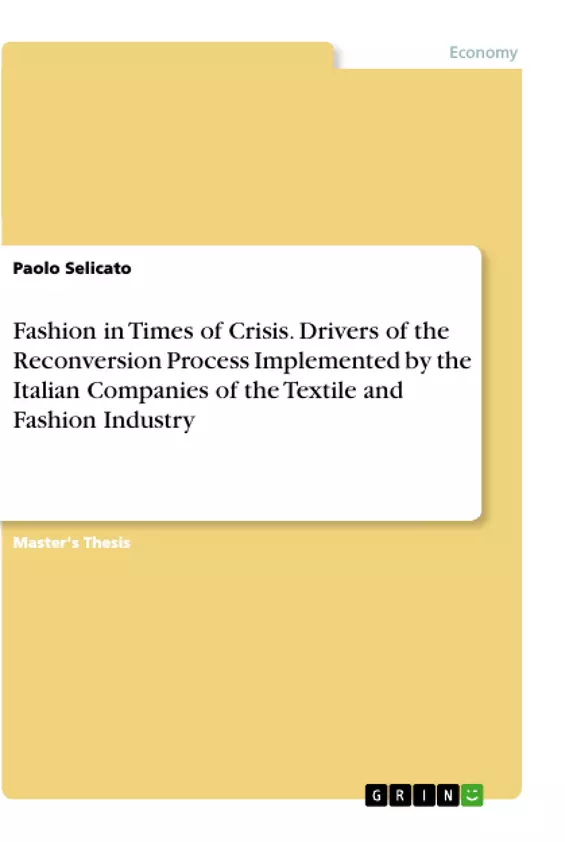Fashion and Textile companies are currently producing face-masks because of the national sanitary emergency. To do that, in March 2020 they reconverted to produce a different product from those belonging to the core business. This study aims to explain how companies of a specific sector, the fashion and textile one, answered to an exogenous crisis, dividing this process in rationale, opportunities and challenges, key factors of the reconversion, and future changes in the reference industry caused by Covid-19.
Though the implementation of a qualitative study, eight companies were interviewed for this work and the information analysed through a two-cycle coding process (i.e. 1st order codes and 2nd order themes) to produce similarities and dissimilarities in reference to the reconversion process. Comparing themes between firms produced important answers to the research question in the form of four theoretical categories, that were constantly related with the literature reviewed and the secondary data analysis. This has provided further corroboration to the empirical evidence suggested in this dissertation.
This work provides explanations of this reconversion process, starting from its rationale to the analysis of the opportunities and challenges that matched the companies’ resources and competences endowment. The dissertation finally offers findings that can be tested and implemented in future research.
Inhaltsverzeichnis (Table of Contents)
- INTRODUCTION
- OVERVIEW
- RESEARCH PURPOSE
- SIGNIFICANCE OF THE STUDY
- RESEARCH OBJECTIVE
- STRUCTURE OF THE STUDY
- METHODOLOGY AND RESEARCH DESIGN
- OVERVIEW
- RESEARCH PHILOSOPHY AND APPROACH
- RESEARCH STRATEGY
- Strategy
- Choice
- Time Horizon
- DATA COLLECTION
- Interview protocol
- Primary data-set
- Secondary Data
- Sources
- Access and Ethical Issues
- CONCLUSION
- LITERATURE REVIEW
- OVERVIEW
- EVOLUTION THEORY
- APPROACH TO EXOGENOUS CRISIS
- EXPLORATION VS. EXPLOITATION STRATEGIES
- KEY CAPABILITIES
- CONCEPTUAL FRAMEWORK
- CONCLUSION
- ANALYSIS
- OVERVIEW
- CANONS AND PROCEDURE
- CODING PROCESS
- First Order Coding
- Second Order Coding
- Theoretical categories and data structure
- CONCLUSION
- PRESENTATION AND DISCUSSION OF THE FINDINGS
- OVERVIEW
- GROUNDED MODEL
- FINDINGS
- Rationale of the reconversion process
- Opportunities and organizational changes for the reconversion process
- Key Factors of the reconversion process
- Adaptive capacity of the industry
- Circular Economy implementation
- DISCUSSION
- CONCLUSION
- CONCLUDING THOUGHTS ON THE CONTRIBUTION OF THIS RESEARCH, ITS LIMITATIONS AND SUGGESTIONS FOR FURTHER RESEARCH
- OVERVIEW
- IMPLICATIONS OF FINDINGS FOR THE RESEARCH QUESTIONS
- CONTRIBUTIONS AND LIMITATIONS OF THE RESEARCH
- RECOMMENDATIONS FOR FUTURE RESEARCH
- FINAL CONCLUSION AND REFLECTIONS
Zielsetzung und Themenschwerpunkte (Objectives and Key Themes)
This dissertation examines how Italian textile and fashion companies responded to the COVID-19 crisis by reconverting their production to produce face masks. The study aims to understand the rationale, opportunities, challenges, and key factors involved in this reconversion process, as well as the potential future changes in the industry as a result of the pandemic.
- The rationale behind the reconversion process
- The opportunities and organizational changes associated with reconversion
- Key factors influencing the success of the reconversion process
- The adaptive capacity of the textile and fashion industry
- The implementation of circular economy principles within the reconversion process
Zusammenfassung der Kapitel (Chapter Summaries)
The introductory chapter provides an overview of the research, including its purpose, significance, objective, and structure. The methodology chapter outlines the research design, data collection techniques, and ethical considerations. The literature review chapter examines relevant theoretical frameworks and prior research on crisis management, organizational adaptation, and key capabilities. The analysis chapter details the data analysis process, including first-order coding, second-order coding, and the development of theoretical categories. The findings chapter presents the main results of the study, focusing on the rationale, opportunities, challenges, and key factors related to the reconversion process. The concluding chapter summarizes the contributions and limitations of the research, offers recommendations for future studies, and provides final reflections on the findings.
Schlüsselwörter (Keywords)
The study focuses on the textile and fashion industry, corporate adaptation to exogenous crises, reconversion processes, circular economy, organizational capabilities, and qualitative research methodologies.
- Arbeit zitieren
- Paolo Selicato (Autor:in), 2020, Fashion in Times of Crisis. Drivers of the Reconversion Process Implemented by the Italian Companies of the Textile and Fashion Industry, München, GRIN Verlag, https://www.grin.com/document/1066494



